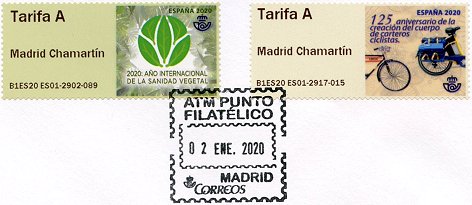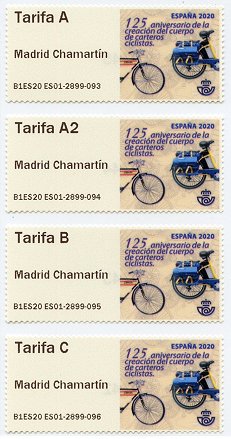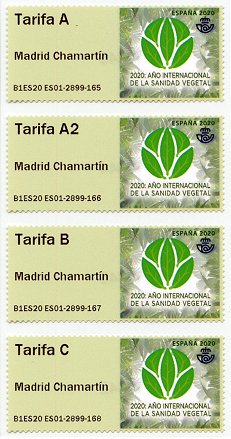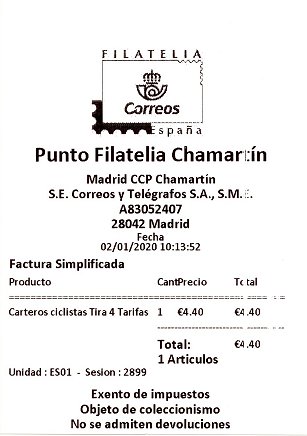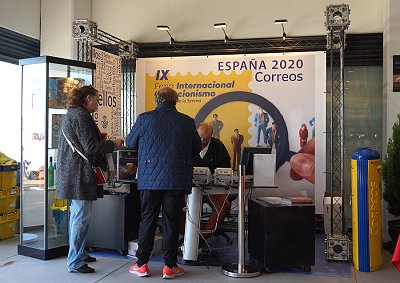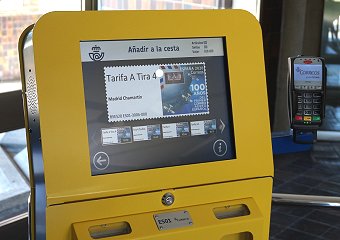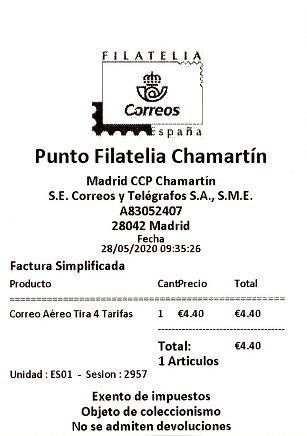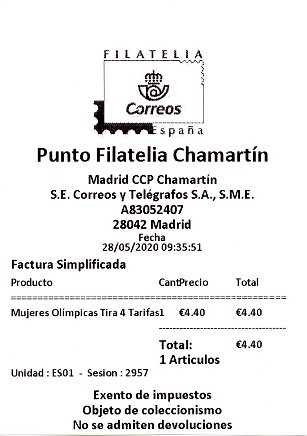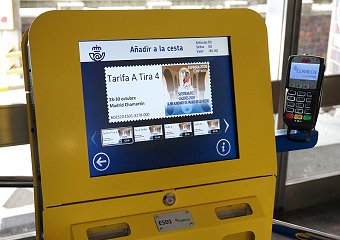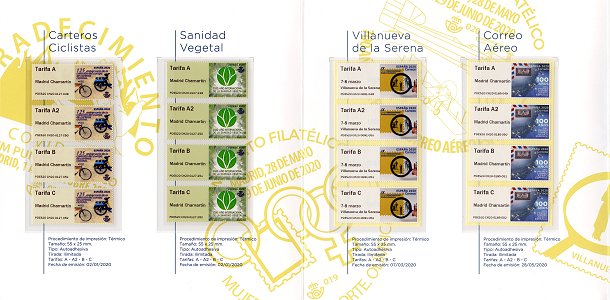|
The contents of this page and the website in general are protected by copyright.
The unauthorized copy of the text and / or images to other sites (even with private access) or publications is prohibited.
Infractors will be immediately expelled from our Group.
| The definitive issues of 2020 |
The Correos philatelic service has planned the release of eight new designs of variable value stamps or 'etiquetas franqueadoras ATM' (ATM franking labels) for 2020.
The first two designs can be considered as definitives and are available at the ES01 philatelic kiosk which is permanently installed in the lobby of the Chamartín mail processing centre, in Madrid. In addition to these there are six special temporary designs, issued on the occasion of the main philatelic events attended by Correos throughout the year.
The first two issues were available from January 2nd 2020. As in the previous three years, one of the designs is dedicated to a philatelic/postal subject, and the other to a social theme. The design called 'Carteros ciclistas' (Postmen Cyclists ) commemorates (one year late) the 125th anniversary of the creation of the Cyclist postmen group, and depicts partial images of a historic bicycle and a modern electric bicycle. The 'Sanidad vegetal' (Plant Health) design features the 'International Year of Plant Health' logo, a commemoration aimed at raising global awareness on how protecting plant health can help end hunger, protect the environment and boost economic development.
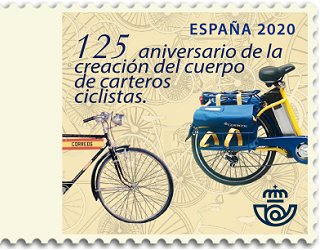 |
 |
Past and present. The 'Cuerpo de Carteros Repartidores Velocipedistas' was created in Spain by Royal Assent on September 13th 1894, to improve the speed and reduce costs of mail deliveries. In Madrid, for example, bicycles were used to transport mail from the center to neighbourhoods on the outskirts of the city.
The first bicycles used by Spanish postmen were the Swift bicycles, originally manufactured in England by Coventry Machinists Co., although most were later manufactured in Madrid by the local firm of Domingo Álvarez, under the DAL brand (upper maximum card). One of these bicycles is on display at the Madrid Postal and Telegraphic Museum, and is also illustrated on one of the stamps of a series issued by the philatelic service in 1999 (for internal use) depicting images of pieces from the Museum (image below).
As part of the 2008-2010 'Environmental Excellence Plan', Correos replaced its delivery fleet with 80 new Borondo and Yamamoto electric bicycles (right maximum card), to be used for the urgent delivery of mail and parcels. The new bicycles contribute to reducing the environmental impact of the previous mode of transport, since they replace the old internal combustion motorcycles. |
|
 |
 |
 |
Both designs are by Juan Antonio González, the main designer in the Correos philatelic department.
The rolls of 1,500 thermal self-adhesive labels were manufactured by Walsall/Cartor Security Printers. The size of the label is 55 x 25 mm., with perforations around the edges. The labels come fixed on a film or transparent backing paper, and are digitally printed.
Unfortunately, the left hand part of the label reserved for the stamp printing is not white, nor does it include a neutral preprinted security background like the last 2019 issues (see articles, also published in VARIABLE 55), but is of a solid light-colored background, which is not optimum for thermal printing.
All the labels are numbered on the back of the release liner, for inventory control. |
|
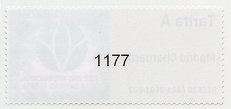 |
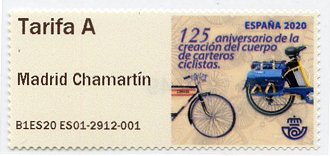 |
 |
 |
| All the stamps issued by the ES01 kiosk at its permanent location include the 'Madrid Chamartín' imprint.
On the bottom of the stamps, printed on the first day of issue, the first block of code is B1ES20, indicating that the stamps were issued in the month of January (1), followed by the machine code (ES01), the session (2912 in the images) and stamp numbers. |
The kiosk is currently programmed to issue stamps with four face value indicators only, Tarifa A, A2, B and C. These indicators correspond to the domestic postal rates for letters up to 20 and 50g, the rates to European countries and the rest of the world up to 20g, respectively.
Users can purchase the stamps as singles and also in two programmed sets or strips; a strip of four Tarifa A stamps ('Tarifa A Tira 4' on the receipts) and a set including the four rates ('Tira 4 Tarifas') (see images below). After issuing the stamps, the machine prints a receipt on thermal paper with the all details of the purchase.
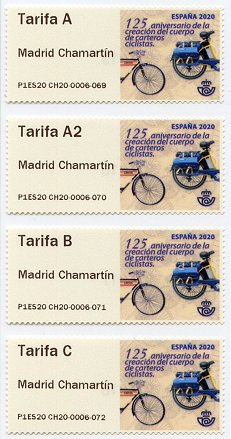 |
 |
|
In addition to the ES01 philatelic kiosk, both designs were obtainable from the back office computer system used by the philatelic service.
In this latter case although the impression of the face value indicator and the ' Madrid Chamartín ' permanent text is similar to that of the kiosk, the first block of code at the bottom of the stamps produced by the philatelic service starts with the letter 'P' (Production).
The machine code for all the stamps issued during 2020 is CH20 (CHamartín 2020) - see table below. |
CORREOS at the Feria Internacional de Coleccionismo in Villanueva de la Serena.
Codes IC20 & CH20 |
 |
|
At the end of January 2020, Correos announced its participation at the Villanueva de la Serena International Collecting Fair, in Extremadura, west of Spain. This Fair, the main national collecting event has been held since 2012 in the Juan Hidalgo multipurpose hall, organized by the 'Estremadura Baxa' collecting cultural association.
In its ninth year, the Fair was held over the weekend of Saturday March 7th and Sunday March 8th 2020, just one week before the Spanish government decreed the state of emergency and lockdown due to the coronavirus crisis. However, the 2020 Fair brought together some 150 national and international exhibitors, and received more than 15,500 visitors. |
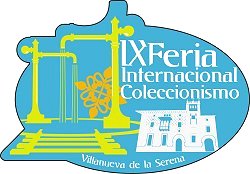 |
| With an incredible annual growth thanks to the great work of its director, Juan Carlos Ojeda, the fair has expanded since 2018 with the addition of a marquee, to an area of more than 3,600 square meters. In addition, from next year the Fair will be held over three days. |
|
 |
Correos attended the Villanueva de la Serena Fair with a small stand set up at the back of the main hall, selling several commemorative philatelic products; including in particular, and related to our field of study, a new ATM issue as well as a postcard, covers and up to three postmarks.
For the printing of the Fair's star product, the ATM stamp, Correos had installed one of its desktop computer equipments, fitted with two direct thermal printers, on the stand. Unfortunately, one of the printers broke down and, despite enormous efforts the problem remained unsolved and no stamps were printed during the two days of the Fair.
Therefore, unable to print stamps in Villanueva, the staff decided to take orders from the visitors, to be printed the following week in Madrid and sent onwards by mail to customers. |
|
 |
The design is again by Juan Antonio González.
As with previous issues, the rolls of thermal self-adhesive labels were manufactured by Walsall/Cartor Security Printers, although with a new change in format. We thought that after the Santander EXFILNA designs (see article, also published in VARIABLE 55), Correos had reached an optimal standard format, with labels on an attractive transparent film liner and a pre-printed neutral security background with the Correos logo, on the left of the label. However, the issue for Villanueva reverts to the features of the first designs, with the yellow silicone coated release liner and the left hand area for printing on a white background. |
|
 |
 |
 |
The stamps issued by the computer system with this design include the ' 7-8 marzo Villanueva de la Serena ' imprint in two lines under the face value indicator. The first block of the bottom code is P3ES20 (P for Production, 3 for the month of March, the code of the country of issue, and 20 for the year), followed by the temporary machine code at this exhibition (IC20, Internacional Coleccionismo 20), and finally the session and stamp numbers.
As usual, this design is only available with the four basic programmed tariffs A, A2, B and C (see table below). The system allows for the printing of single stamps, strips of four stamps for domestic mail ('Tarifa A Tira 4' on receipts), and strips of four stamps with the four rates ('Tira 4 Tarifas' on receipts - image below), all of them delivered with the appropriate thermal paper receipt. |
|
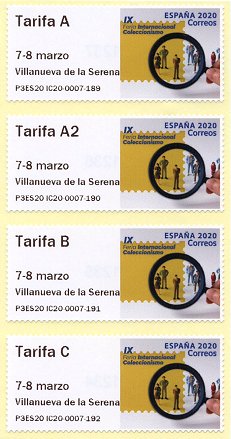 |
|
 |
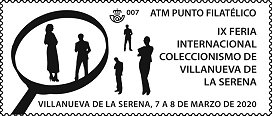 |
|
 |
| In addition to the ATM issue, Correos produced a special pictorial cover (right) and a new postcard or 'Tarjeta emisión máxima' (image below). |
| Three commemorative postmarks were also available; two general postmarks of the Fair, including a large rectangular one (above), and a special one for the Maximum Card, depicting the Cross of the Order of Alcántara, which is part of the city's coat of arms. |
|
 |
 |
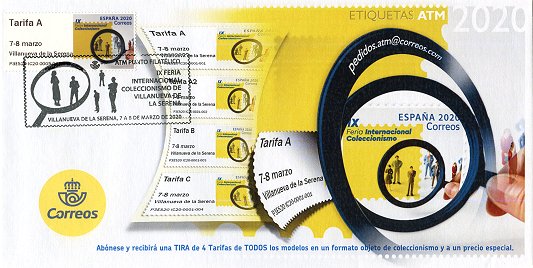 |
|
Left, promotional envelope produced by Correos. |
Since 2012, the organizers of the Fair have been issuing personalized stamps illustrated with the fair's annual logo. In addition, since 2015 they have also requested Correos produce a special postmark with the same design. The cover depicted below, produced by the organization, includes the ATM issue, the personalized stamp, and the special postmark for the 2020 Fair.
 |
|
The logo of the 9th. Fair is dedicated to two city highlights, a modern ornamental fountain recreating a section of railway with two old water pumps used to supply the steam locomotives, |
| and the Casa de los Bolos, a residential building built in the early 20th century. |
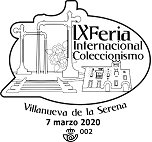 |
 |
|
This design was also available from the philatelic service, with equipment code CH20. In this case, the first block of the bottom code of these stamps is variable, depending on the print date. In the image, P3ES20 indicates that the four-value set was issued in the same month of March (3). |
| 100 years of the first Spanish Airmail service & Women in Olympic sport. Codes ES01 & CH20 |
Just one week after the Villanueva Collecting Fair (see article, published in VARIABLE 56), the Spanish government declared a state of countrywide lockdown on March 14th 2020 as a result of the health emergency caused by the Covid-19 virus. With an initial duration of fifteen days, the lockdown was further extended during the following months, and in fact remained in force until June 21st.
As a direct consequence of this declaration, the organizers of the Madrid National Stamp Fair decided to cancel the 2020 annual event, which was to be held in late May. However, the philatelic service continued with the release of the two planned variable value stamp issues, albeit with some design variations.
| The first design marks the centenary of the first Spanish airmail service. The first route was inaugurated on April 1st 1920 and included Barcelona - Alicante - Malaga. The design depicts an aerial view of the Mediterranean coast in which the three airports are marked with the profile of the Breguet XIV plane used on the first flight. In the upper left corner the designer has included the characteristic chequered colors of an airmail envelope, and a proof of an unissued 1923 airmail stamp designed by Camilo Delhom. |
|
 |
| 2020 was to be an Olympic year and the 52nd National Stamp Fair event would have been dedicated to women in Olympic sport; the theme of the second variable value stamp issue. The initial design (left below) in purple included an interpretation of the Olympic rings in which the two lower rings have been replaced by two graphics symbolizing stamp collecting and women. The final design (right), now without the text referring to the National Stamp Fair, features the profiles of women in different Olympic disciplines with the same interpretation of the Olympic rings below. The philatelic service produced a postcard with the same design (right). |
|
 |
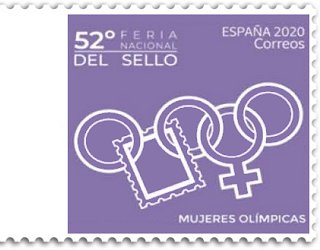 |
 |
 |
|
In 1918 Pierre-Georges Latécoère proposed the creation of an air route between France and its African colonies, to the French government, with stops in Spain and Morocco. The first test flight, on December 25th 1918, covered the route between Toulouse and Barcelona. The regular route between Toulouse - Casablanca was established the following year, with stops in Barcelona, Alicante, Malaga, Tangier and Rabat (left maximum card). The Spanish government took advantage of the creation of this route to contract Latécoère for a Spanish specific route connecting the three Mediterranean cities. |
 |
Maximum card below. Since 1920 Latécoère had his own airfield and hangar next to the Volatería airfield, on the land that today is occupied by the Prat de Llobregat airport, in Barcelona. Latécoère used different types of aircraft, especially the Breguet XIV featured in the postcard, the stamp and in the special postmark.
Right, the beloved Blanca Fernández Ochoa, the first Spanish woman to get an Olympic medal, a bronze in the slalom event at the Albertville Winter Olympics in 1992. |
|
 |
 |
| The philatelic service was also intending to issue two 'traditional' stamps and two postal stationery cards (below) dedicated to the same themes during the Stamp Fair, but its release was eventually delayed until the end of June. |
|
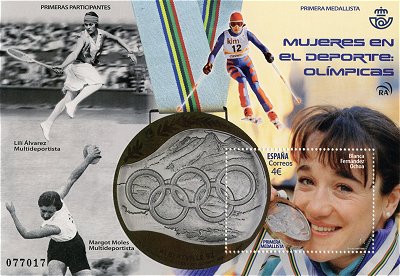 |
 |
 |
With the National Stamp Fair canceled, the philatelic service decided to release the two new variable value stamp commemoratives on May 28th, (the scheduled date of the opening of the Fair), at the ES01 philatelic kiosk which is permanently installed in the lobby of the Chamartín mail processing centre, in Madrid (right image and front cover of VARIABLE 57). The staff placed a table next to the kiosk, with pictorial covers, information, and the essential hand sanitiser gel ...
These two designs were only available from this machine for a month, until June 29th, and were then replaced by the two definitive designs issued in January 2020.
The rolls of 1,500 thermal self-adhesive labels were manufactured by Walsall/Cartor Security Printers. The labels are digitally printed and have the same features as those produced for Villanueva de la Serena, with the left hand area for the printing on a white background and with a yellow silicone coated release liner. |
|
 |
The ES01 kiosk was programmed with the usual four postage rate indicators, which make up the sets or 'Tira de 4 tarifas' (images below), Tarifa A, A2, B and C. All stamps issued include the permanent 'Madrid Chamartín' imprint below the face value indicator. Receipts printed on thermal paper were issued along with the stamps.
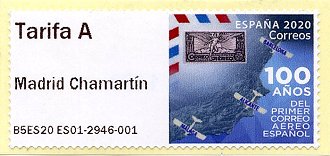 |
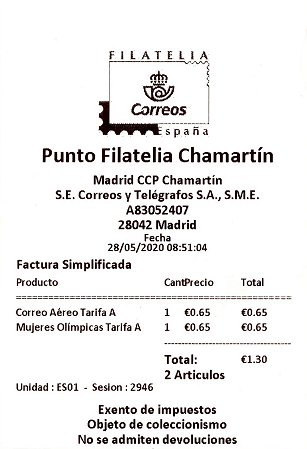 |
 |
| On the bottom of the stamps printed in May, the first block of code is B5ES20, followed by the machine code (ES01), the session (2946 in the images) and stamp numbers. |
|
 |
|
 |
| Complementing these two new issues of variable value stamps, the philatelic service also produced and sold two |
|
| related pictorial covers, and prepared two special postmarks, depicting the Breguet XIV airplane and the Olympic rings graphic. |
|
 |
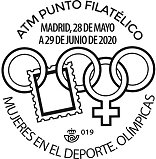 |
|
 |
|
They also produced the usual promotional envelope depicting both designs ... perhaps the last one? |
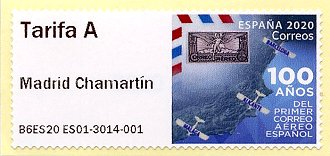 |
 |
 |
| Both issues were also available throughout the month of June 2020. As can be seen in the images, the first block of the code printed at the bottom of the stamps printed in June is B6ES20. |
|
 |
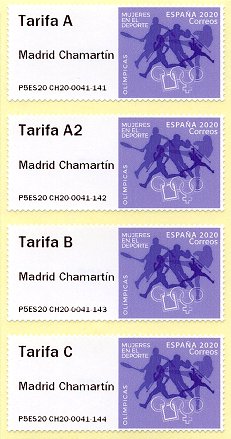 |
|
In addition to the ES01 philatelic kiosk, both designs were obtainable from the back office computer system used by the philatelic service, with the annual code CH20.
In this latter case whilst the impression of the face value indicator and the 'Madrid Chamartín' permanent text is similar (not identical) to that of the kiosk, the first block of code at the bottom of the stamps produced by the philatelic service however, starts with the letter 'P' (Production).
The first block of the bottom code of these stamps varies, depending on the print date. In the images, P5ES20 indicates that the stamps were issued in the month of May 2020. |
| Special issue 'Agradecimiento. COVID-19'. Codes ES01 & CH20 |
 |
|
2020 will be remembered as one of the worst years in mankind's recent history. The great crisis associated with the COVID-19 pandemic has affected the whole world, and its consequences are still quite possibly unknown. Postal administrations around the world have amended their philatelic programs and released special issues in recognition of the international efforts in fighting this terrible pandemic. It had to be that way, since philately is and has to be a testimony and reflection of society today.
Correos de España also wanted to pay tribute and show its gratitude ('Agradecimiento') to the entire population and to the professionals and workers categorised as 'essential' i.e. those who have worked, sometimes under very trying conditions, so that the rest of the population continued to have their needs met. And gratitude especially towards the health workers who continue to fight on the front line against the pandemic. To date in Spain more than 60 health workers have died from COVID-19. |
| Among the special issues, on October 1st 2020 Correos released, a souvenir sheet and an ATM issue. The miniature sheet features a group of health workers with a patient; the reversible stamp shows two intertwined hands as a symbol of support, hands which then "clap" as the stamp is turned. Correos also produced a postal stationery card with the same design. |
|
 |
The ATM stamp features a group of people clapping, something that was repeated daily throughout the country for about two months, as a way of thanking all the heroes of this pandemic.
The design of this issue, as well as other ATM issues, is by Juan Antonio González, the main designer in the Correos philatelic department. The rolls of 1,500 thermal self-adhesive labels were manufactured by Walsall/Cartor Security Printers, and are digitally printed. The size of the label is 55 x 25 mm., and comes fixed on a yellow silicone coated release liner. |
|
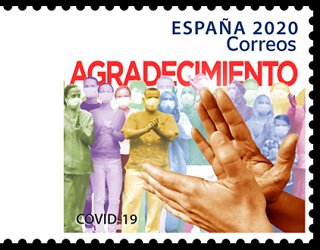 |
| As with the sensible precedent set for the National Stamp Fair issues (which was cancelled - see previous article, published in VARIABLE 57), the philatelic service manager decided to release the special design from the ES01 philatelic kiosk which is installed in the lobby of the Chamartín mail processing centre, in Madrid. |
|
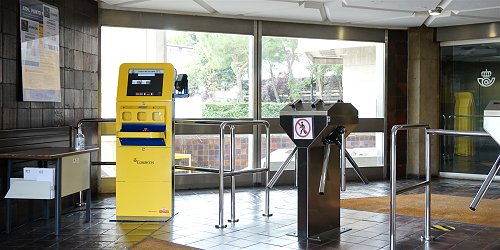 |
| The 'Agradecimiento - COVID-19' design was available from the kiosk's two printers for just four weeks, from October 1st to 27th, when it was then replaced by the two new Exfilna issues (see next article). |
|
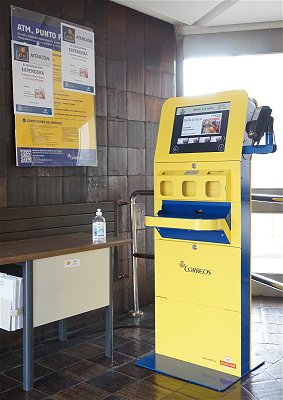 |
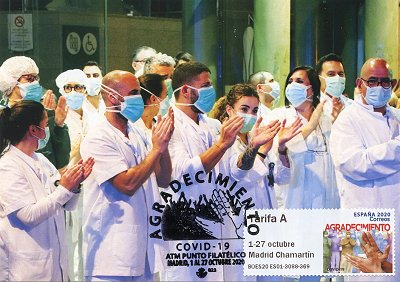 |
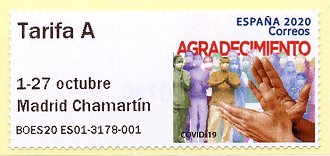 |
 |
The stamps issued by the philatelic kiosk include the ' 1-27 octubre Madrid Chamartín ' imprint in two lines under the face value indicator. The first block of the bottom code is BOES20, followed by the machine code (ES01), the session (3178 in the stamp and receipt) and stamp numbers.
As per usual, the ES01 kiosk was programmed with four basic tariffs A, A2, B and C (see table below). Users can purchase single stamps, strips of four stamps for domestic mail ('Tarifa A Tira 4' on receipts - left column below), and strips of four stamps with the four rates ('Tira 4 Tarifas'- right column), all sold with the appropriate thermal paper receipt. |
|
 |
|
 |
| As part of this ATM issue, the philatelic service also prepared an appropriate special postmark and a pictorial commemorative cover. |
|
 |
|
As previously, in addition to the ES01 philatelic kiosk, this design was also available from the back office computer system used by the philatelic service, with the annual code CH20. The first block of the bottom code of these stamps also varies, depending on the print date. In the image, POES20 indicates that the four-value set was issued in the same month of October 2020. |
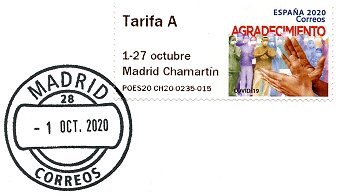 |
| The ATM issues for the EXFILNA VIRTUAL 2020. Codes ES01 & CH20 |
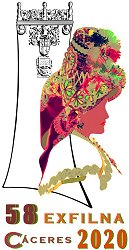 |
|
Following on from the Santander EXFILNA in 2019 (see article, published in VARIABLE 55), the 58th annual National Philatelic Exhibition was to be held from October 28th to November 1st 2020 in Cáceres, Extremadura, in the western part of Spain. However, the health crisis and the restrictions put in place throughout the year as a result of the pandemic meant that a such an exhibition would not be possible during the last quarter of 2020. Eventually, at the beginning of June, the organizers the Asociación Cultural Filatélica y Numismática Cacereña, announced the cancellation of this philatelic event. |
| The exhibition logo, designed by María Adela Cornejo Martínez, combines two outstanding images of the city, the silhouette of one of the towers of the Palacio de los Golfines de Abajo, one of the venues planned for the exhibition, and the image of a woman dressed in the typical Montehermoso costume, with her prominent and spectacular hat. |
However, in order to continue with the 'concept' of an EXFILNA philatelic exhibition, the Spanish Federation of Philatelic Societies (FESOFI), with the sponsorship of Correos, decided to organize a virtual exhibition via a web page set up by FESOFI. The first VIRTUAL EXFILNA was held on the same planned dates, from October 28th to 31st. The 125 collections were accessible online until the end of November. In addition, during the four days, visitors were able to "virtually attend" the 11 scheduled presentations of books and lectures. Although not the first time that a virtual philatelic exhibition had been held in Spain, the organizers confirmed a very large number of visits and significant interest in this new format.
However, on the same dates, Correos and the local and regional stamp associations organized a symbolic tribute to the cancelled National Philatelic Exhibition Exfilna 2020, by way of a publicly restricted exhibition held at the Palacio de los Golfines de Abajo, in Cáceres. |
|
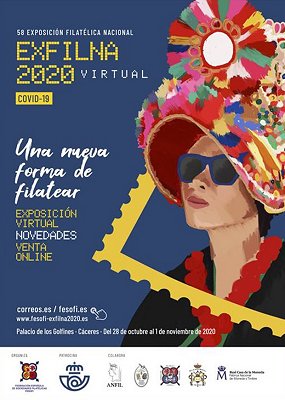 |
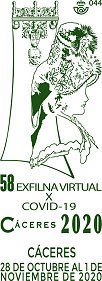 |
|
Even with a virtual EXFILNA, Correos continued with the release of the usual philatelic issues planned for this major annual event, although a wise and sensible decision was made to include special overprints on some of the items released to record the exceptional circumstances of the 2020 event. In particular, the overprint 'EXFILNA VIRTUAL X COVID 19' was included in the folded souvenir sheet dedicated to the Palacio de los Golfines - both on the stamp within the sheet, which reproduces one of the Palace frescoes (right), and on the official first day cover (depicted below). |
 |
| This text also appears in the special large-size postmark featuring the exhibition logo (left), in a green colour alluding to the autonomous community of Extremadura. |
 |
As in previous years, Correos also launched two new issues of variable value stamps -or 'etiquetas ATM' as Correos refers to these stamps- for the EXFILNA of Cáceres. These were illustrated with the EXFILNA 2020 logo and motifs relating to the city. The 'Aljibe' (water tank) design, dedicated to the Almohad cistern of the Palacio de las Veletas, and the 'Toledo-Moctezuma' design, with an image of the tower of this Palace. The series designs, as well as the postmarks and special covers, are by Juan Antonio González, from the Correos design and image department. The rolls of 1,500 self-adhesive thermal labels were manufactured by Walsall/Cartor Security Printers.
Note that the designs include '58 EXFILNA/ECC', which refers to the 7th European Convention for Collectors (ECC), organized by ANFIL and to be held during EXFILNA.
 |
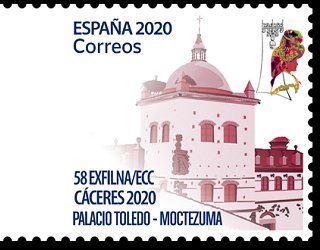 |
Maximum card below.
The Palacio de las Veletas occupies the area of the former Almohad fortress, in which is preserved the cistern to store rainwater. The vaulted naves are supported by 16 horseshoe arches on 12 columns, some of Roman origin.
Right. The Toledo-Moctezuma Palace is a Renaissance-style building built and renovated between the 15th and 17th centuries. The name comes from the marriage between Mariana de Carvajal and Toledo with Juan de Toledo Moctezuma, grandson of the Aztec emperor. |
|
 |
 |
| Both designs were again available from the ES01 philatelic kiosk installed in the lobby of the Chamartín mail processing centre, in Madrid. Although the EXFILNA was virtual, these designs were only available for the three working days in which the EXFILNA would have been held, from Wednesday October 28th to Friday 30th; the only days the kiosk was accessible and supervised by the staff. |
|
 |
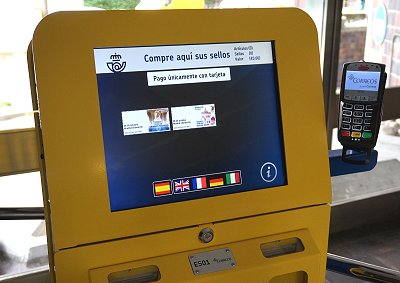 |
|
During these three days, the machine issued stamps of both designs with the '28-30 octubre Madrid Chamartín' imprint in two lines under the face value indicator. The kiosk was programmed with the usual four postage rate indicators, which make up the sets or 'Tira de 4 tarifas' (images below), Tarifa A, A2, B and C. Receipts printed on thermal paper were issued along with the stamps. |
 |
 |
 |
| Available for just three days, the first block of code printed on the bottom of each stamp begins with BOES20, followed by the machine code (ES01), the session (3217 in the images) and stamp numbers. |
|
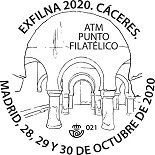 |
|
 |
| Along with these two variable value stamp issues, the philatelic service produced two commemorative covers, which also included the 'EXFILNA VIRTUAL X COVID 19' imprint. |
|
| It should be noted and thanks once again go to the philatelic service in preparing special postmarks for each of the two ATM designs. |
|
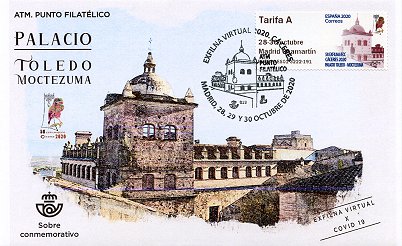 |
 |
|
 |
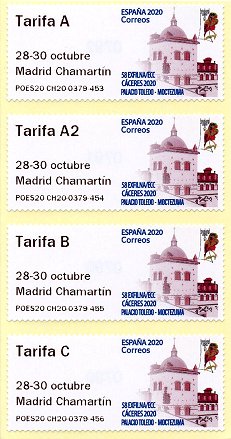 |
|
Both designs were also available from the back office computer system used by the philatelic service, with the annual code CH20. The first block of the bottom code of the stamps printed in October is POES20 (images),
unlike the strips included in the annual philatelic folder, also issued with the CH20 equipment, but which are dated December (PDES20). |
| The philatelic service editions - 2020. Code CH20 |
In 2020 the Correos philatelic service produced the fifth presentation pack with all the ATM designs issued during the year. This nice pictorial double page foldout folder includes the information on the different issues and pictures of all associated special postmarks. The print run is 2,000 folders, with most going to collectors with standing orders for this type of issue.
The eight designs appear in mint strips with the usual four-value set (Tarifa A - A2 - B - C), placed in protective stamp mounts, with the kiosk’s first day of issue permanent or temporary imprint.
| All the sets were printed in December 2020 with the back office computer system used by the philatelic service. The first two blocks of the code at the bottom of all the stamps in the folder are PDES20 CH20, followed by the session and stamp numbers. |
|
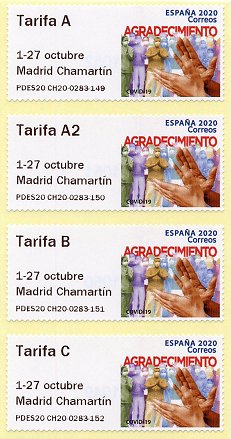 |
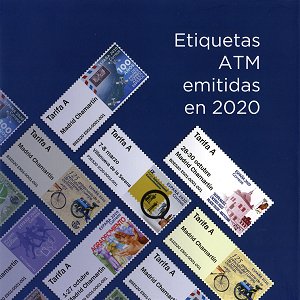 |
|
| Spain ATMs (2016 - ...) - Machine codes table |
| Machine code |
Equipment |
Operating period |
Location |
| B004 |
IAR philatelic kiosk |
From September 2016 until May 2017 |
CCP Chamartín, Madrid |
| CH17 |
Computer system |
From June 2017 until December 31st 2017 |
CCP Chamartín, Madrid |
| CH18 |
Computer system |
From January 2nd to December 31st 2018 |
CCP Chamartín, Madrid |
| CH19 |
Computer system |
From January 2nd to December 31st 2019 |
CCP Chamartín, Madrid |
| CH20 |
Computer system |
From January 2nd to December 31st 2020 |
CCP Chamartín, Madrid |
| ES01 |
IAR philatelic kiosk |
From April 21st 2016 |
CCP Chamartín, Madrid, and philatelic events |
| ES02 |
Computer system |
From May 10th to 13th 2017 |
JUVENIA 2017, Avilés |
| ES18 |
Computer system |
From May 3rd to 5th 2018 |
28th Internationale Briefmarken-Messe, Essen, Germany |
| EX17 |
Computer system |
From October 9th to 15th 2017 |
EXFILNA 2017, Portugalete |
| EX18 |
Computer system |
From October 31st to November 4th 2018 |
EXFILNA 2018, Sevilla |
| EX19 |
Computer system |
From November 6th to 10 2019 |
EXFILNA 2019, Santander |
| IC20 |
Computer system |
March 7th & 8th 2020 |
IX Feria Internacional Coleccionismo
(9th International collecting fair),
Villanueva de la Serena, Extremadura |
| JU19 |
Computer system |
From May 7th to 11th 2019 |
JUVENIA 2019, Burgos |
| MA18 |
Computer system |
From September 21st to 24th 2018 |
35th Asian International Stamp Exhibition, Macao |
| PA19 |
Computer system |
From November 7 to 9th 2019 |
73rd Salon Philatélique d'Automne, Paris |
| PM17 |
Computer system |
From May 25th to 28th 2017 |
49th Feria Nacional del Sello, Madrid |
| PM18 |
Computer system |
From April 19th to 22nd 2018 |
50th Feria Nacional del Sello, Madrid |
| PM19 |
Computer system |
From June 12th to 16th 2019 |
51st Feria Nacional del Sello, Madrid |
| SPAIN - Basic postal tariffs (2016 - ...) |
| |
Domestic up to 20g. |
Domestic up to 50g. |
Europe |
Rest of the world |
| |
Tarifa A |
Tarifa A2 |
Tarifa B |
Tarifa C |
| 1.01.2016 |
0,45 € |
0,57 € |
1,15 € |
1,30 € |
| 1.01.2017 |
0,50 € |
0,60 € |
1,25 € |
1,35 € |
| 1.01.2018 |
0,55 € |
0,65 € |
1,35 € |
1,45 € |
| 1.01.2019 |
0,60 € |
0,70 € |
1,40 € |
1,50 € |
| 1.01.2020 |
0,65 € |
0,75 € |
1,45 € |
1,55 € |
| ATEEME, in collaboration with GALERIA ATM, offers you the option to take out a standing order for all the new Spain ATM issues (sets, first day covers, varieties, etc.) at reduced prices. Contact us for more information. |
The contents of this page and the website in general are protected by copyright.
The unauthorized copy of the text and / or images is prohibited.
ATM Web - Spain and Latin American Postal Services: http://www.ateeme.net
© J. Jove - ATEEME. Variable value stamps study group. All rights reserved
This page was created in March 2020 and last updated:
09.02.21
. English edition last rewritten by J. Gareze (27.12.2020)
|










